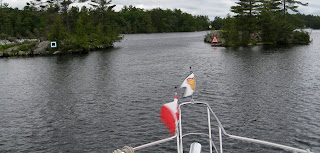Departed Orillia with the plan to stop short of the Big Chute for the night and tie up at the Government docks. We took one look at those when we arrived and continued on to Big Chute.

Geologists claim the bottom at the north end of Lake Couchiching rises 1 foot per century. What I find fascinating is the reason this is happening is the land is rebounding from the pressure put upon it some 12,000 years ago by glaciers!
The predominant species of birds on this lake
 appear to be cormorants. We saw this island from a distance and thought it looked frost covered. As we got closer we could see the trees had many cormorants in them. Almost every square inch of the trees and island was covered with their droppings.
appear to be cormorants. We saw this island from a distance and thought it looked frost covered. As we got closer we could see the trees had many cormorants in them. Almost every square inch of the trees and island was covered with their droppings.We spent part of the day on Lake Couchiching. It is a big area of water, but not without it’s rocks. There is a section of buoys here that the locals refer to as “the bowling alley”. One can understand why. It reminded us of my dad’s expression of “keep ‘er between the fence posts”.

 The day was going well until we had to stop and wait for this decrepit old railroad bridge to be open. It is normally open and wouldn’t you know they were working on it. A 15 minute wait turned into half and hour. Not a big deal, but this is a narrow area we are in not much margin for error to have to hover around in.
The day was going well until we had to stop and wait for this decrepit old railroad bridge to be open. It is normally open and wouldn’t you know they were working on it. A 15 minute wait turned into half and hour. Not a big deal, but this is a narrow area we are in not much margin for error to have to hover around in.While waiting we did see quite a bit of wildlife. A
 muskrat swam by and also this huge snapping turtle. We could see the start of a beaver lodge. I think the builder was evicted earlier because none of the sticks looked very fresh. You can understand why we wouldn’t want to get our props tangled in this.
muskrat swam by and also this huge snapping turtle. We could see the start of a beaver lodge. I think the builder was evicted earlier because none of the sticks looked very fresh. You can understand why we wouldn’t want to get our props tangled in this.When they could finally swing the bridge for us it made a deafening, metal on metal screeching sound. I believe the bridge is at least 100 years old, and I’m thinking someone forgot to oil it.
 We passed though areas today that look just like the boundary waters of Minnesota.
We passed though areas today that look just like the boundary waters of Minnesota.This shot is as we entered McDonald’s Cut. This is
 an example of the many narrow rock lined cuts that took so long to complete in order to make this area navigable. The work would all been done by hand, and probably some explosives as there was no machinery in 1905 when this was done.
an example of the many narrow rock lined cuts that took so long to complete in order to make this area navigable. The work would all been done by hand, and probably some explosives as there was no machinery in 1905 when this was done. Another not so very fun spot that Ross had to navigate the boat through. It’s the Flat Rapids. They perhaps don’t look like rapids, but the water was swirling and squirrelly making it difficult to control the boat. And you can see from the picture, he had to keep it to the left of the green markers. Which put us very close to shore! You will have to double click on the photo to see what I'm talking about.
Another not so very fun spot that Ross had to navigate the boat through. It’s the Flat Rapids. They perhaps don’t look like rapids, but the water was swirling and squirrelly making it difficult to control the boat. And you can see from the picture, he had to keep it to the left of the green markers. Which put us very close to shore! You will have to double click on the photo to see what I'm talking about.We were relieved to arrive at the Big Chute for the evening.

After the long day of boat driving,
 the skipper needed ice cream!
the skipper needed ice cream!Before.

After.
Our fellow Minnesotans in the SOUTHERN BELLE showed up also and we had the entire docks to ourselves.
This was the view at dusk that we shared off our back decks.

















































